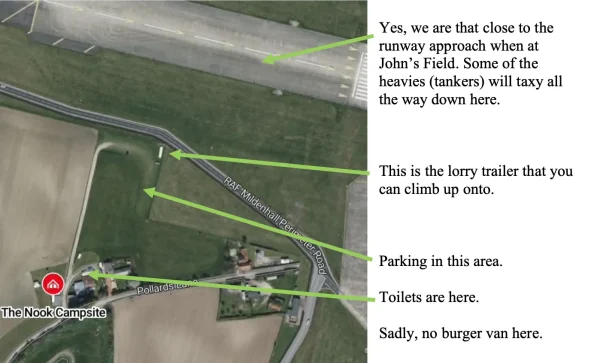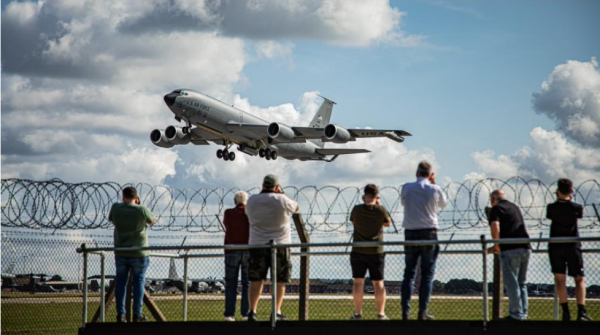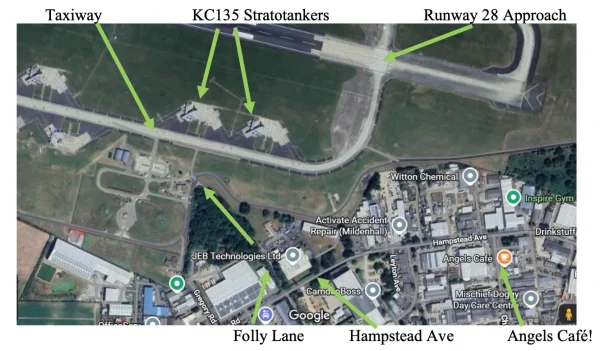David J. Bray AFIAP, CPAGB, E.CPE
This guide aims to provide you with the appropriate information if you are looking to plan a visit to photograph the military aviation action at RAF Mildenhall in Suffolk. It will give you information about locations to try, and the type of equipment that you will need to get the best out of your images.
Important
This is an active military base and so you need to be mindful of security. NEVER attempt to fly a drone in the vicinity of an air base
General Equipment & Tips
This guide is applicable mainly for Monday to Friday, although flying is never guaranteed.
You may see limited flying at weekends here, but the base is normally closed at Public Holidays including those observed in the USA e.g. Thanksgiving, Super Bowl Weekend, Veterans Day, Martin Luther King Day.
When planning a trip to this location, aeroplanes from sleek and fast fighter jets to large multi-engine transport types can be seen. As such, you should consider taking lenses that give you a range of between 24 and 400mm. For the purposes of this guide, you are ‘unlikely’ to need anything bigger than 400mm.
For this type of photography, I always use ‘Shutter Priority’ but of course, you don’t have to. I use ‘Shutter Priority’ because I can set the speed of the shutter according to the action, I retain control of the ISO/Exposure, but let the camera control the aperture.
Fast Jets
Consider starting with a shutter speed of 1/2000th of a second, or even 1/2500th of a second and see how you go. As you become more comfortable with panning, you can always bring the shutter speed down and retain a sharp subject, with the possibility of gaining motion blur in the background as you pan/track the aircraft.
If it’s a nice sunny day, you will be able to go for a reasonably low ISO at those kinds of shutter speed. I always take some test shots to confirm the exposure, and if the lighting conditions are changeable through the day, keep taking occasional test shots and alter your ISO or shutter speed accordingly. Whatever works for you to capture your images.
As the sun goes down, naturally, you will have no real alternative but to reduce the shutter speed and try your best to successfully pan/track the aircraft so that the subject remains sharp. Winter sunset skies can be incredible for more creative aviation photography.
Large Transports (Jets)
I pretty much use the same settings as I do for fast jets. However, the large transports are bigger targets, easier to track/pan and so you are free to select your own shutter speed/ISO as you see fit. I would suggest somewhere between 1/800th of a second and 1/1500th of a second for these as a starting point, remembering to adjust your ISO to suit the conditions.
Large Transports (Propeller/Turbo-Prop)
Some of the transport types have rotating propellers and it is good practice to try and have the image you take capture the fact that the propellers are spinning. If your shutter speed is too high, it will look like the propellers are not spinning, and where the aircraft is in the air, that just looks ‘wrong.’
So, for this type of aircraft, you want your shutter speed to be as low as you dare – consider 1/250th of a second or less. Experienced (and by that I mean far better than me) photographers of this genre can shoot this type of aircraft at 1/80th of a second or less and keep the aircraft sharp with good movement of the propellers captured.
Don’t be afraid to experiment there with your settings, but if it’s your first time and you really want to keep this type of aircraft nice and sharp in your image, I would start at a higher shutter speed.
Helicopters
Helicopters and Tilt-Rotor aircraft have rotors that help to keep them in the air. In comparison with the ‘turbo-propeller’ type aircraft referred to above, helicopter rotors are more tricky to capture and represent the motion blur as they spin far more slowly, even though to the naked eye they spin fast.
For these, you really need to have a shutter speed of around 1/200th of a second or less when they are in the air. If they have slowed down to finally land or are hovering, quickly swap your shutter speed and try 1/80th or even 1/20th of a second and see how much rotor blur you can get whilst keeping the aircraft itself nice and sharp.
Note
I always use the auto-focus because of… well, they’re fast moving subjects. And I always have my image stabiliser on when doing this type of photography handheld.
Okay then, let’s have a look at RAF Mildenhall…
RAF Mildenhall

Set your sat-nav for postcode IP28 8RA, which is Pollards Lane, Mildenhall. This will get you into the area nicely for Location 1. From Rugby, it is a relatively easy and about 95 miles using the A14, A11 and A1101.
Things to know before you go though
Barton Mills Roundabout (where you get off the A11 and onto the A1101) is a good place to top up with fuel, and there’s a MacDonalds, which I use to collect breakfast in the way to where I usually go at the base.
Officially, unless stated, there are NO TOILET facilities at RAF Mildenhall for some of the locations I will show below. However, you can pop back to that MacDonalds at Baron Mills, or drive into Mildenhall town itself where you’ll find convenient supermarkets.
Location 1 – John’s Field
Accessed via The Nook campsite. Sat Nav: IP28 8RA, Pollards Lane, Mildenhall, Suffolk.
From the Barton Mills roundabout, that the A1101 into Mildenhall. At Police Station Square, you’ll leave the A1101 and pick up the B1102 (Queensway) which becomes West Road and then becomes Mildenhall Road.
You will eventually need to turn right into Jarmans Lane, then right again to pick up Pollards Lane. Entrance to the campsite and John’s Field will be on the left. John’s Field is available from around 08:00 hours each day until 20:00 hours, or sunset, whichever is earliest.
Although this is a campsite, John’s Field itself is designed for day visitors coming to see the aviation action at Mildenhall. It is at the Western end of the runway and there is ample parking. It costs about £2.00 per guest as a day visitor but the action is normally worth it on a flying day.
Drive very slowly as the ground is uneven – it pays to to drive slowly.
The good news is that John’s Field has toilets – but please treat them with respect!
Once parked up, you are adjacent to the end of the runway with good views of arriving or departing traffic, depending on which direction they are using. Some of the transport aircraft you’ll see will fill the lens very quickly, particularly zoom lenses. For some of the action here, a 24-105mm lens is adequate.
The use of stepladders is up to you. It is possible to shoot at/through the fence, and there’s even a flat-bed lorry trailer that you can climb up onto (deliberately placed) and with a modest 2-step ladder, see over the fence.
John’s Field is a great place to view the action from, especially if you’re a first-time visitor to Mildenhall. Ideal for picnics and generally less of a scrum.
Regular aircraft to be seen include the Mildenhall based KC-135 Stratotankers, though you’ll often see tankers from elsewhere, including KC-46 Pegasus which are militarised Boeing 767s. Also based there are the C-130J Hercules used by US Special Forces, along with the MV-22 Osprey tilt rotor aircraft. Be prepared for the Hercules and Ospreys to operate late afternoon and into the evening.
You will also have the chance of seeing the ‘white tops’ RC-135 Rivet Joint aircraft or WC-135 Constant Phoenix (radiation sniffer) aircraft based on the Boeing 707 airframe, like the Stratotankers.


Location 2
Folly Lane, Mildenhall, IP28 7RQ(accessed off Hampstead Avenue). Folly lane is a right turn off Hampstead Avenue at JEB Technologies. As you drive along the road, it is a bit of a forested/tree area and on the right you will see the airfield perimeter fence. Park on the left-hand side where space permits. Do not park adjacent to the airfield fence.
Remember: There is no toilet here!
Once parked up, you are adjacent to the eastern end of the runway with good views of arriving or departing traffic depending on which direction they are using. You’re a little bit further away from the action at this end, so you’ll want a lens range of between 24 and 400/500mm.
Whilst it is possible to photograph through the fence, particularly with longer zoom lenses, a stepladder is recommended (4-5 steps) to see over the fence for a truly unobstructed shot.
Not great here first thing in the morning as you’ll be shooting into the sun, but the light does move round behind you later in the day.

Angels Cafe on Chiswick Avenue is great – the do all sorts of stuff in there and it is very popular with RAF Mildenhall staff/aircrew. However, it is not cheap. I’ve only ever used takeaway there, but there is a toilet/washroom in there which is obviously for customer use only. The cafe closes at 3pm and is the home of the “big-ass burrito.”
There is a third viewing location known as “the mound.” It is on waste ground but requires a very delicate off-road parking position to avoid grief from the locals. I won’t include it in this guide, but will happily talk about it off-line and if we’re on a trip to Mildenhall, I will show you what to do and where to go. It is accessed off Field Road (A1101).






